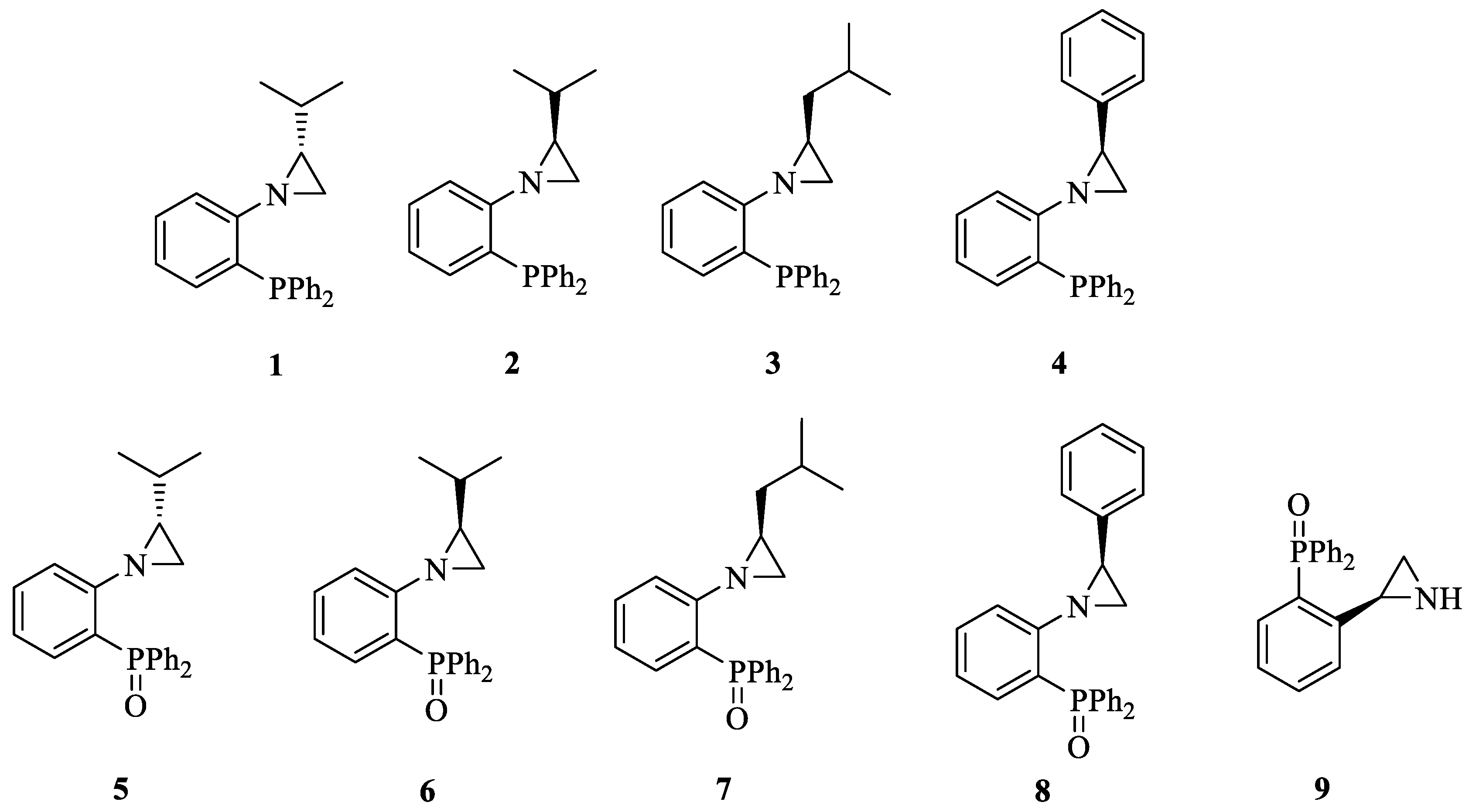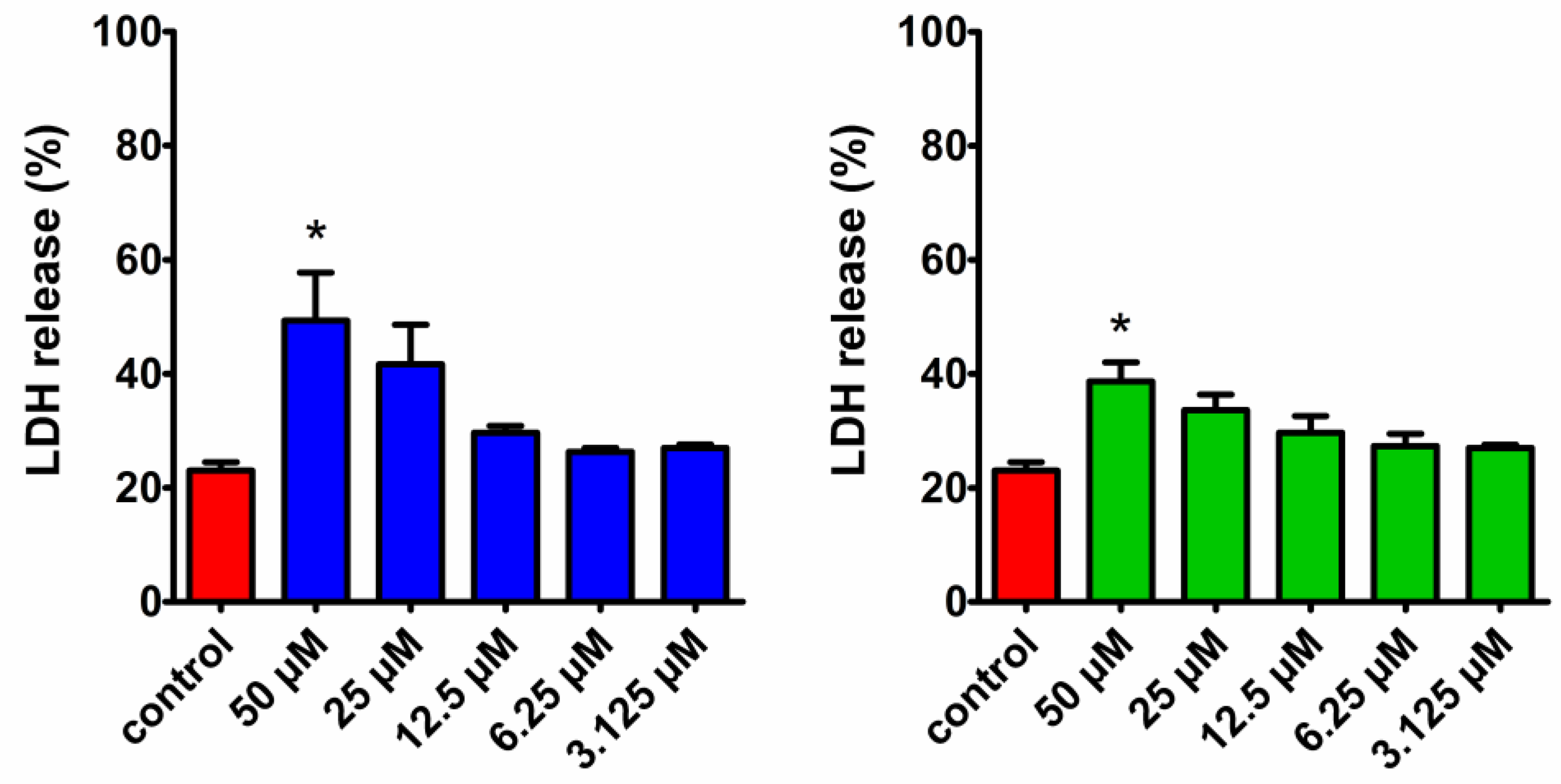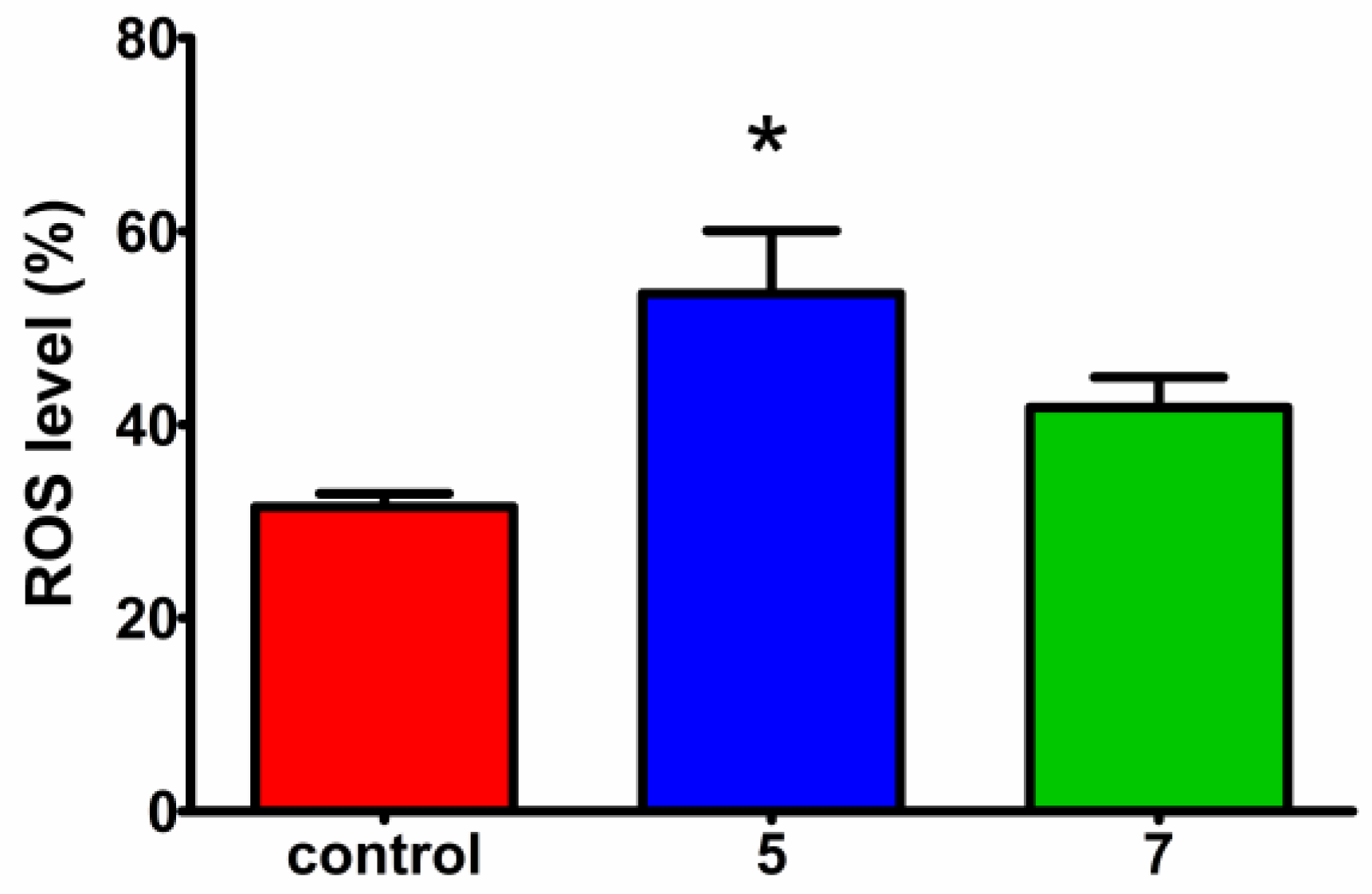A Study on the Biological Activity of Optically Pure Aziridine Phosphines and Phosphine Oxides
Abstract
1. Introduction
2. Results and Discussion
2.1. Chemistry
2.2. Biology
2.2.1. Antibacterial Activity
2.2.2. Cell Viability Inhibition
2.2.3. LDH Release Assay
2.2.4. Cell Cycle Analysis
2.2.5. Reactive Oxygen Species Measurement
3. Materials and Methods
4. Conclusions
Supplementary Materials
Author Contributions
Funding
Institutional Review Board Statement
Informed Consent Statement
Data Availability Statement
Acknowledgments
Conflicts of Interest
References
- Sweeney, J.B. Aziridines: Epoxides’ ugly cousins? Chem. Soc. Rev. 2002, 31, 247–258. [Google Scholar] [CrossRef] [PubMed]
- Singh, G.S. Chapter Four-Advances in synthesis and chemistry of aziridines. In Advances in Heterocyclic Chemistry; Scriven, E.F.V., Ramsden, C.A., Eds.; Academic Press: Cambridge, MA, USA, 2019; pp. 245–335. [Google Scholar] [CrossRef]
- Faure, R.; Loiseleur, H.; Bartnik, R.; Leśniak, S.; Laurent, A. Bis(benzoylaziridine)dibromozinc (II) (ZRBr2(C9H9NO)2). Cryst. Struct. Commun. 1981, 10, 515–519. [Google Scholar]
- Bartnik, R.; Leśniak, S.; Laurent, A. Reduction stereospecifique de complexes aziridinyl-cetones-bromure de zinc. Tetrahedron Lett. 1981, 22, 4811–4812. [Google Scholar] [CrossRef]
- Leśniak, S.; Rachwalski, M.; Pieczonka, A.M. Optically pure aziridinyl ligands as useful catalysts in the stereocontrolled synthesis. Curr. Org. Chem. 2014, 18, 3045–3065. [Google Scholar] [CrossRef]
- Budzisz, E.; Bobka, R.; Hauss, A.; Roedel, J.N.; Wirth, S.; Lorenz, I.-P.; Rozalska, B.; Więckowska-Szakiel, M.; Krajewska, U.; Rozalski, M. Synthesis, structural characterization, antimicrobial and cytotoxic effects of aziridine, 2-aminoethylaziridine and azirine complexes of copper(II) and palladium(II). Dalton Trans. 2012, 41, 5925–5933. [Google Scholar] [CrossRef] [PubMed]
- Doğan, Ö.; Babiz, H.; Gözen, A.G.; Budak, S. Synthesis of 2-aziridinyl phosphonates by modified Gabriel–Cromwell reaction and their antibacterial activities. Eur. J. Med. Chem. 2011, 46, 2485–2489. [Google Scholar] [CrossRef] [PubMed]
- Barr, P.M.; Miller, T.P.; Friedberg, J.W.; Peterson, D.R.; Baran, A.M.; Herr, M.; Spier, C.M.; Cui, H.; Roe, D.J.; Persky, D.O.; et al. Phase 2 study of imexon, a prooxidant molecule, in relapsed and refractory B-cell non-Hodgkin lymphoma. Blood 2014, 124, 1259–1265. [Google Scholar] [CrossRef] [PubMed]
- National Center for Biotechnology Information. PubChem Compound Summary for CID 68791, Imexon. 2023. Available online: https://pubchem.ncbi.nlm.nih.gov/compound/Imexon (accessed on 25 May 2023).
- Zheng, M.; Hwang, S.; Snyder, T.; Aquilina, J.; Proni, G.; Paz, M.M.; Pradhan, P.; Cheng, S.-Y.; Champeil, E. Synthesis of Mitomycin C and decarbamoylmitomycin C N6 deoxyadenosine-adducts. Bioorg. Chem. 2019, 92, 103280. [Google Scholar] [CrossRef]
- Coleman, R.S.; Perez, R.J.; Burk, C.H.; Navarro, A. Studies on the Mechanism of Action of Azinomycin B: Definition of Regioselectivity and Sequence Selectivity of DNA Cross-Link Formation and Clarification of the Role of the Naphthoate. J. Am. Chem. Soc. 2002, 124, 13008–13017. [Google Scholar] [CrossRef]
- Coleman, R.S.; Li, J.; Navarro, A. Total Synthesis of Azinomycin A. Angew. Chem. Int. Ed. 2001, 40, 1736–1739. [Google Scholar] [CrossRef]
- Suzuki, M.; Kambe, M.; Tokuyama, H.; Fukuyama, T. Enantioselective Total Synthesis of FR900482. J. Org. Chem. 2004, 69, 2831–2843. [Google Scholar] [CrossRef] [PubMed]
- Kowalczyk, A.; Pieczonka, A.M.; Rachwalski, M.; Leśniak, S.; Stączek, P. Synthesis and Evaluation of Biological Activities of Aziridine Derivatives of Urea and Thiourea. Molecules 2018, 23, 45. [Google Scholar] [CrossRef] [PubMed]
- Witusik-Perkowska, M.; Głowacka, P.; Pieczonka, A.M.; Świderska, E.; Pudlarz, A.; Rachwalski, M.; Szymańska, J.; Zakrzewska, M.; Jaskólski, D.J.; Szemraj, J. Autophagy Inhibition with Chloroquine-Increased Pro-Apoptotic Potential of New Aziridine–Hydrazide Hydrazone Derivatives against Glioblastoma Cells. Cells 2023, 12, 1906. [Google Scholar] [CrossRef] [PubMed]
- Buchcic, A.; Zawisza, A.; Leśniak, S.; Rachwalski, M. Asymmetric Friedel–Crafts Alkylation of Indoles Catalyzed by Chiral Aziridine-Phosphines. Catalysts 2020, 10, 971. [Google Scholar] [CrossRef]
- Wujkowska, Z.; Zawisza, A.; Leśniak, S.; Rachwalski, M. Phosphinoyl-aziridines as a new class of chiral catalysts for enantioselective Michael addition. Tetrahedron 2019, 75, 230–235. [Google Scholar] [CrossRef]
- Popovics-Tóth, N.; Bálint, E. Multicomponent Synthesis of Potentially Biologically Active Heterocycles Containing a Phosphonate or a Phosphine Oxide Moiety. Acta Chim. Slov. 2022, 69, 735–755. [Google Scholar] [CrossRef] [PubMed]
- Carraminana, V.; Ochoa de Retana, A.M.; Velez del Burgo, A.; de los Santos, J.M.; Palacios, F. Synthesis and biological evaluation of cyanoaziridine phosphine oxides and phosphonates with antiproliferative activity. Eur. J. Med. Chem. 2019, 163, 736–746. [Google Scholar] [CrossRef] [PubMed]
- Finkbeiner, P.; Hehn, J.P.; Gnamm, C. Phosphine Oxides from a Medicinal Chemist’s Perspective: Physicochemical and in Vitro Parameters Relevant for Drug Discovery. J. Med. Chem. 2020, 63, 7081–7107. [Google Scholar] [CrossRef]
- Benaglia, M.; Rossi, S. Chiral phosphine oxides in present-day organocatalysis. Org. Biomol. Chem. 2010, 8, 3824–3830. [Google Scholar] [CrossRef]
- Tajti, A.; Emőke Szabó, K.; Popovics-Tóth, N.; Iskanderov, J.; Perdih, F.; Hackler, L., Jr.; Kari, B.; Puskás, G.L.; Bálint, E. PMDTA-catalyzed multicomponent synthesis and biological activity of 2-amino-4H-chromenes containing a phosphonate or phosphine oxide moiety. Org. Biomol. Chem. 2021, 19, 6883–6891. [Google Scholar] [CrossRef]
- Gorbachuk, E.; Badeeva, E.; Gubaidullin, A.; Samigullina, A.; Voloshina, A.; Sapunova, A.; Hey-Hawkins, E.; Sinyashin, O.; Yakhvarov, D. Bis(α-hydroxycycloalkyl)phosphine Oxides Obtained from White Phosphorus via Phosphine Oxide H3PO: Synthesis, Molecular Structure, Coordination Properties and Biological Activity. ChemPlusChem 2020, 85, 958–962. [Google Scholar] [CrossRef] [PubMed]
- Merk, O.; Speit, G. Detection of crosslinks with the comet assay in relationship to genotoxicity and cytotoxicity. Environ. Mol. Mutagen. 1999, 33, 167–172. [Google Scholar] [CrossRef]
- Wijeratne, S.S.; Patel, J.M.; Kiang, C.H. Melting Transitions of DNA-Capped Gold Nanoparticle Assemblies; Springer: New York, NY, USA, 2012; pp. 269–282. [Google Scholar]
- Ivanov, V.I.; Minchenkova, L.E.; Schyolkina, A.K.; Poletayev, A.I. Different conformations of double-stranded nucleic acids in solution as revealed by circular dichroism. Biopolymers 1973, 12, 89–110. [Google Scholar] [CrossRef]
- Dvorakova, K.; Payne, C.M.; Tome, M.E.; Briehl, M.M.; McClure, T.; Dorr, R.T. Induction of oxidative stress and apoptosis in myeloma cells by the aziridine-containing agent imexon. Biochem. Pharmacol. 2000, 60, 749–758. [Google Scholar] [CrossRef]
- Dorr, R.T.; Raymond, M.A.; Landowski, T.H.; Roman, N.O.; Fukushima, S. Induction of apoptosis and cell cycle arrest by imexon in human pancreatic cancer cell lines. Int. J. Gastrointest. Canc. 2005, 36, 15–28. [Google Scholar] [CrossRef] [PubMed]
- Buchcic, A.; Zawisza, A.; Leśniak, S.; Adamczyk, J.; Pieczonka, A.M.; Rachwalski, M. Enantioselective Mannich Reaction Promoted by Chiral Phosphinoyl-Aziridines. Catalysts 2019, 9, 837. [Google Scholar] [CrossRef]
- ISO 20776-1; Susceptibility Testing of Infectious Agents and Evaluation of Performance of Antimicrobial Susceptibility Test Devices—Part 1: Broth Micro-Dilution Reference Method for Testing the In Vitro Activity of Antimicrobial Agents against Rapidly Growing Aerobic Bacteria Involved in Infectious Diseases. International Organization for Standardization: Geneva, Switzerland, 2019. Available online: https://www.iso.org/obp/ui/#iso:std:iso:20776:-1:ed-2:v2:en (accessed on 1 March 2024).
- ISO 10993-5; Biological Evaluation of Medical Devices Part 5: Tests for In Vitro Cytotoxicity. nternational Organization for Standardization: Geneva, Switzerland, 2009. Available online: https://www.iso.org/standard/36406.html/ (accessed on 1 March 2024).





| IC50 (µM) | ||||
|---|---|---|---|---|
| L929 | HeLa | Ishikawa | ||
| Aziridine phosphines | 1 | 68.1 ± 11.2 | >100 (SI < 1) | 13.9 ± 7.1 (SI = 4.9) |
| 2 | >100 | >100 (SI–nd) | 14.8 ± 6.5 (SI > 6.7) | |
| 3 | >100 | 30.3 ± 4.5 (SI > 3.3) | >100 (SI–nd) | |
| 4 | 22 ± 3.4 | 39.2 ± 6.7 (SI < 1) | >100 (SI < 1) | |
| Aziridine phosphine oxides | 5 | 10.6 ± 3.2 | 6.4 ± 2.1 (SI = 1.7) | 4.6 ± 2.3 (SI = 2.3) |
| 6 | 13.7 ± 3.1 | 40.7 ± 11.1 (SI < 1) | 16.6 ± 2.5 (SI < 1) | |
| 7 | 17.5 ± 2.1 | 7.1 ± 2.6 (SI = 2.5) | 10.5 ± 3.1 (SI = 1.7) | |
| 8 | 17.0 ± 4.4 | 19.6 ± 3.2 (SI < 1) | 23.4 ± 7.6 (SI < 1) | |
| 9 | >100 | 48.8 ± 12.3 (SI > 2.0) | >100 (SI–nd) | |
| CisPt | 26.2 ± 7.5 | 10.4 ± 4.4 (SI > 2.5) | 17.3 ± 5.2 (SI = 1.5) | |
Disclaimer/Publisher’s Note: The statements, opinions and data contained in all publications are solely those of the individual author(s) and contributor(s) and not of MDPI and/or the editor(s). MDPI and/or the editor(s) disclaim responsibility for any injury to people or property resulting from any ideas, methods, instructions or products referred to in the content. |
© 2024 by the authors. Licensee MDPI, Basel, Switzerland. This article is an open access article distributed under the terms and conditions of the Creative Commons Attribution (CC BY) license (https://creativecommons.org/licenses/by/4.0/).
Share and Cite
Kowalczyk, A.; Pieczonka, A.M.; Kassassir, H.; Rachwalski, M.; Stączek, P. A Study on the Biological Activity of Optically Pure Aziridine Phosphines and Phosphine Oxides. Molecules 2024, 29, 1430. https://doi.org/10.3390/molecules29071430
Kowalczyk A, Pieczonka AM, Kassassir H, Rachwalski M, Stączek P. A Study on the Biological Activity of Optically Pure Aziridine Phosphines and Phosphine Oxides. Molecules. 2024; 29(7):1430. https://doi.org/10.3390/molecules29071430
Chicago/Turabian StyleKowalczyk, Aleksandra, Adam M. Pieczonka, Hassan Kassassir, Michał Rachwalski, and Paweł Stączek. 2024. "A Study on the Biological Activity of Optically Pure Aziridine Phosphines and Phosphine Oxides" Molecules 29, no. 7: 1430. https://doi.org/10.3390/molecules29071430
APA StyleKowalczyk, A., Pieczonka, A. M., Kassassir, H., Rachwalski, M., & Stączek, P. (2024). A Study on the Biological Activity of Optically Pure Aziridine Phosphines and Phosphine Oxides. Molecules, 29(7), 1430. https://doi.org/10.3390/molecules29071430








